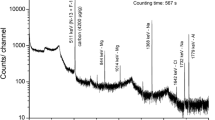Abstract
Na, Mg, Al and Cl in Roman glasses and pottery were analyzed by PIGE with 2.5 MeV protons and 2.0 MeV deuteron activation analysis. Both methods are simple and rapid. For Na, Mg and Al in glasses, the detection limits with PIGE and deuteron activation are: 40, 800, 300 (µg/g) and 120, 110, 100 (µg/g), respectively. PIGE is not suitable for trace analysis of chlorine. The detection limit of Cl is 500 µg/g for 2 MeV deuteron activation. PIGE is a sensitive method for Na analysis. At low concentrations of Mg and Al, deuteron activation with its higher sensitivity and improved photopeak-to-background ratios, gives more precise and accurate results than PIGE.




Similar content being viewed by others
References
Deconninck G (1978) Introduction to radioanalytical physics. Elsevier, Amsterdam
Giles IS (1978) Elemental analysis by alpha-induced prompt gamma-ray emission. PhD thesis, University of Cape Town, South Africa
Kenny MJ, Bird JR, Clayton E (1980) Proton induced gamma-ray yields. Nucl Instrum Methods Phys Res 168:115–120
Gihwala D (1982) Analytical application of proton-induced prompt photon spectrometry. Ph.D. thesis, University of Cape Town, South Africa
Sastri CS, Schelhaas KP (1985) Analytical use of alpha-source induced Gamma-ray emission, Fresenius. J Anal Chem 321:739–747
Elekes Z, Kiss AZ, Biron I, Calligaro T, Salomon J (2000) Thick target γ-ray yields for light elements measured in the deuteron energy interval of 0.7–3.4 MeV. Nucl Instrum Methods Phys Res B 168:305–320
Sastri CS, Iyengar V, Blondiaux G, Tessier Y, Petri H, Hoffmann P, Aras NK, Zaichick V, Ortner HM (2001) Fluorine determination in human and animal bones by particle-induced gamma-ray emission, Fresenius. J Anal Chem 370:924–929
Petrone P, Graziano V, Sastri C, Sauvage T, Mezzasalma M, Paternoster M, Guarino F (2019) Dental fluorosis in the Vesuvius towns in AD 79: a multidisciplinary approach. Ann Hum Biol 46:388–392
Gomez-Tubio B, Ontalba-Salamanca MA, Ortega-Feliu I, Respaldiza MA (2006) PIXE-PIGE analysis of late roman glass fragments. Nucl Instrum Methods B 249:616–621
Smit Z, Milavec T, Fajfar H, Rehren Th, Lankton JW, Gratuze B (2013) Analysis of glass from the post-Roman settlement Tonovcov grad (Slovenia) by PIXE-PIGE and LA-ICP-MS. Nucl Instrum Methods Phys Res B 311:53–59
Dasari KB, Chhillar S, Acharya R, Ray DK, Behera A, Lakhmana Das N, Pujari PK (2014) Simultaneous determination of Si, Al and Na concentrations by particle induced gamma-ray emission and applications to reference materials and ceramic archaeological artifacts. Nucl Instrum Methods Phys Res B 339:37–41
Speakman RJ, Little NC, Creel D, Miller MR, Inanez JG (2011) Sourcing ceramics with portable XRF spectrometers? A comparison with INAA using Mimbres pottery from the American Southwest. J Archaeol Sci 38:3483–3496
Hoffmann P, Vetter G (1990) Analytical examination of mortars from the medieval derelict village Holzheim. Fresenius J Anal Chem 338:133–137
Glascock MD, Neff H (2003) Neutron activation analysis and provenance research in archaeology. Meas Sci Technol 14:1516–1526
Seaborg GT, Livingood JJ (1938) Artificial radioactivity as a test for minute traces of elements. J Am Chem Soc 60:1784–1786
Albert Ph, Chaudron G, Süe P (1953) Microdosage par voie chimique du carbonne dans le fer irradie par les deutons. Bull Soc Chim Fr 20:97–102
Albert Ph, Blondiaux G, Debrun JL, Giovagnoli J, Valladon M, (1987) Activation cross-sections for elements from lithium to Sulphur, Handbook on Nuclear Activation data, Technical Report Series no. 273, IAEA, Vienna
Sastri CS, Blondiaux G, Petri H, Michulitz M (2000) Stoichiometric determination of carbon in ceramic materials by low energy deuteron activation analysis. J Radioanal Nucl Chem 244:457–462
Misdaq MA, Blondiaux G, Bordes N, Giovagnoli A, Valladon M, Wei IC, Hage Ali M, Maggiore CJ, Debrun JL (1987) Recent progress in the study of semiconductors using charged particle activation. J Radioanal Nucl Chem 110:441–449
Giovagnoli A, Valladon M, Koemmerer C, Blondiaux G, Debrun JL (1979) Etude de la reaction N-14 (d,n)O-15 a basse energie et application au dosage de làzote dans le zirconium. Anal Chim Acta 109:411–418
Sastri CS, Blondiaux G, Hoffmann P, Ortner HM, Petri H (2000) Oxygen determination in calcium fluoride by deuteron activation analysis. Fresenius J Anal Chem 366:218–220
Sastri CS, Blondiaux G, Möller P, Petri H (1996) Determination of chlorine in metals and ceramic materials by low energy deuteron activation analysis. Nucl Instrum Methods Phys Res B 119:425–428
Sastri CS, Blondiaux G, Petri H (1997) Trace determination of carbon, sodium, magnesium and aluminum in metals and ceramic materials by low energy deuteron activation analysis. Nucl Instrum Methods Phys Res B 124:558–566
Peisach M, Gihwala G (1986) Radioactive interference effects in deuteron—induced PIPPS. Radiochim Acta 40:21–25
Ricci E (1972) Charged particle activation analysis. In: Lenihan JMA et al (eds) Advances in activation analysis. Academic Press, Cambridge
Vandecasteele C (1988) Activation analysis with charged particles. Ellis Horwood Limited, Chichester
Chu SYF, Ekström LP, Firestone RB (1999) The Lund/LBNL nuclear data search. Version 2.0. http://www.nucleardata.nuclear.lu.se/toi/
Ricci E, Hahn RL (1967) Sensitivities for activation analysis of 15 light elements with 18 MeV Helium-3 particles. Anal Chem 39:794–797
Ziegler JF, Ziegler MD, Biersack JP (2008) Version SRIM-2008.04. http://www.srim.org
Sastri CS, Banerjee A, Sauvage T, Courtois B, Duval F (2016) Application of 12 MeV proton activation to the analysis of archaeological specimens. J Radioanal Nucl Chem 308:241–249
Author information
Authors and Affiliations
Corresponding author
Additional information
Publisher's Note
Springer Nature remains neutral with regard to jurisdictional claims in published maps and institutional affiliations.
Rights and permissions
About this article
Cite this article
Sastri, C.S., Sauvage, T., Blondiaux, G. et al. Analysis of Na, Mg, Al and Cl in archaeological glass and pottery: comparison of PIGE with low energy deuteron activation analysis. J Radioanal Nucl Chem 324, 159–167 (2020). https://doi.org/10.1007/s10967-020-07035-6
Received:
Published:
Issue Date:
DOI: https://doi.org/10.1007/s10967-020-07035-6




